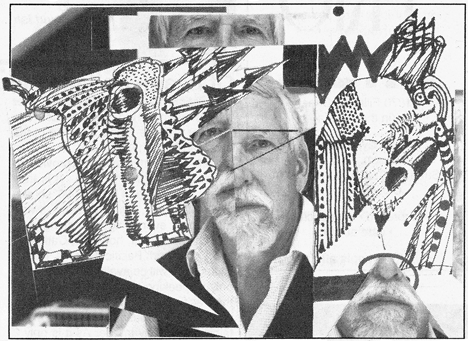LOCALS | DAVID ISH
It is a misleading moniker to call Bill Shields a neighborhood artist. He is indeed an artist who lives less than a block from Fillmore Street. But his work and his life have extended well beyond the neighborhood.
Although born in San Francisco in the Presidio, where his physician father was director of Letterman Hospital, he grew up in San Antonio, Texas, and lived for 12 years in New York and Connecticut, where he was a top flight editorial illustrator for publications including McCall’s, Ladies Home Journal, Time and Fortune.
Prodigious, prolific, fertile and fecund, the constantly creative Shields has often produced more work in a year than some other artists have in their entire careers. And his work, like Picasso’s, is marked by sudden, abrupt discontinuities in style, rather than slow, evolutionary refinement. He finds himself both the victim and the executioner of total departures from his previous directions.
If anything underlies the quantum leaps that have taken him from style to style, it is a deep mastery of craft, a mastery found in the Pine Street house he bought in 1976 and remade through the years with his wife, Denise — to their own delight and the delight of the numerous photographers dispatched by magazines including Sunset, Better Homes and Gardens and Architectural Digest.
Bill and Denise bought the house in 1976, about a year after Bill returned to San Francisco, and just before housing prices had begun their first ascent into madness. The small house — “a shambles,” Bill called it — had an even smaller garage, which faced Wilmot Alley. Bill leveled the garage and put up a new structure housing his studio on top, plus additional studio space he rents to other artists. There is also a two-car garage at the ground level of the studio building.
Standing in the small, bright, skylight punctuated main house, looking out from the copper potted kitchen to the studio across the courtyard, it is impossible not to get the feeling that what lies just behind the studio is not Wilmot Alley but the rocky, raw, pounding Mendocino coastline. The entire effect of being in the house, the courtyard or the studio is of being in the country. Enter through any door and you have moved magically and deeply into the countryside.
Next to the unshakeable feeling of country living, the next-most astonishing thing about the house is the great sense of light and spaciousness. The source of light is most understandable — skylights abound over almost every room and major area. The sense of spaciousness is harder to account for, since the house — which seems to ramble on in all directions, with room after room — is incredibly small and compact.
The sense that flows from the Shields’ house is the same that flows from his work: a sense of abundancy, of overflowing, of constantly more, and more to come, of something happening everywhere and on every level of surprise, of detail, of a full and rich and deeply appreciated life. And of even more. And more again. A tap on some deep inexhaustible, constant source of creativity.
Filed under: Art & Design, Locals





